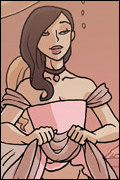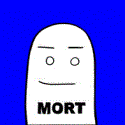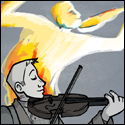|
Arrrthritis posted:I mean, if they're going full dark souls/elden ring with it they could just reflavor healing surges to be their estus flask. I think it makes more sense to replace the name Second Wind with Drink Estus Flask or whatever. Changing healing surges to estus flask can run into confusion considering the word "healing surge" appears hundreds of times among hundreds of items, powers, feats and abilities. You could also give each character a non-transferrable, once-per-encounter potion called an Estus Flask that refills on a short rest. Not sure how much it'd heal, but maybe it gives flat HP like a potion of healing does, and improves when an Estus Flask Shard is found.
|
|
|
|

|
| # ? May 15, 2024 09:31 |
|
lightrook posted:I thin the main thing I'd say about builds is that 4e is a very rewarding game to get very deep in the weeds, but relatively easy to function at baseline. There's only a few really major pitfalls to avoid, the main ones being "have at least a +4 mod in your main stat," "use a +3 proficiency weapon (instead of a +2)," and "play a normal class with normal AEDU powers (i.e. not an Essentials class)." Hybrid classes aren't too bad or broken, as long as their classes have overlapping stats and their AC is normal, and in some ways easier to play since they have fewer passive class features. I guess it does create more room to screw things up if a player doesn't know what they're doing, in a way that normal single classes don't, but a player that does know can create a broken monstrosity regardless, so the real solution is to be open and honest about expected optimization levels. Given this, would anything get broken by just giving all weapons a +3 proficiency bonus? I know the original idea was to balance damage or special abilities of weapons vs the extra +1 to hit, but given how valuable any sources of attack bonuses are in 4e it seems much less relevant than intended.
|
|
|
|
Our DM uses a house rule that gives all Superior weapons and implements a +3 proficiency bonus, and it makes using them much more appealing, because you're not blowing a feat on something actively suboptimal.
|
|
|
|
Lemniscate Blue posted:Given this, would anything get broken by just giving all weapons a +3 proficiency bonus? I know the original idea was to balance damage or special abilities of weapons vs the extra +1 to hit, but given how valuable any sources of attack bonuses are in 4e it seems much less relevant than intended. Giving all weapons +3 proficiency bonus would also necessitate modifying damage rolls to be equal as well, making all weapons essentially the same within a particular group. Which could totally work. Looking into feats and things that grant additional benefits to specific weapon types, maybe there's some kind of balance issue when you get really deep into min-maxing, but honestly I don't think an extra +1 to hit would cause that many headaches. Even now, my player group has two hammer users who perform fairly well at level 8. Ultimately +1 to hit amounts to a 5% additional chance to hit something, which of course is far more optimal than not having an extra 5% chance to hit, but I don't think it breaks the game in any way for them. Verisimilidude fucked around with this message at 15:56 on Jan 25, 2023 |
|
|
|
I'm already making a radical gameplay change when I make a static 1-20 game world and then another 21-30 staged past some narrative barrier and let the players fight whatever they want and whatever they can (or can't!) survive. I do like the idea of taking these "specialization" feats and just gating them behind some battles - there could be some themed enemies in each major tier zone, maybe arena champions, maybe an organization of famed duelists, who knows. Beat them, and you unlock the feat.
|
|
|
|
The math fix feats are strong but kind of boring, I would just give those out for free at campaign start. If you want to lock cool mechanical upgrades behind boss fights or similar, my pick would be alternate encounter / daily powers -- which also fits pretty nicely with things like ashes of war / weapon arts (or, framed a little differently, with trick weapons).
|
|
|
|
So, having another reminder that in a way, D&D4 has an implied structure even more stricter than some of the storygames. In my campaign, I’ve been running adventures in a way that the PC’s would get no chance at a long rest during the adventure. Each adventure was around 4-5 combats on average, with similar amounts of high-risk skill challenges (an awful lot of those focused on running away from things blowing up in the background). It worked pretty great, though. One rule I instituted is that if a skill challenge effect causes you to lose a healing surge when you have none (typically, running away from a collapsing building or floating island at the end of the adventure), you get a “black mark” – some sort of visual reminder of something bad happening to you. The sorcerer ended up with a pock-marked face from one of these, whilst the barbarian proudly bears a collection of scars, each one of which tells a story (“this one came from a shark, this one from a ghoul”). The campaign just hit Paragon level, and for the current adventure I decided to go for a slice-of-life adventure, with several weeks’ in-game downtime between sessions, giving the players an opportunity to indicate what interests their characters are pursuing (they get three “activity tokens” at the end of the session, and a list of goals, both personal and party-wide, that they spend them on). The next session is then mostly dealing with outcome and key decision points from their background activities. So, that works great. Problem is, that’s where the game system buckles up against this style of play. There’s no resource management to consider, since enough in-game time passes between sessions that all dailies and healing surges should be back. I think I’m okay for now – the characters have just hit Paragon, so it’s a nice jump in power for them. But the next adventure is definitely going back to “oh poo poo, we have to go somewhere dangerous, and get there fast before everything blows up!” mode.
|
|
|
|
This is a situation where I would suggest busting out a different system to handle those segments. 4e is largely uninterested in the things that players do that isn't adventuring, which honestly I prefer to the kind of ham fisted attempts 3.x takes at incorporating non-adventure elements.
|
|
|
|
Verisimilidude posted:Giving all weapons +3 proficiency bonus would also necessitate modifying damage rolls to be equal as well, making all weapons essentially the same within a particular group. Which could totally work. Weapon dice literally do not matter past like, level 4. The type of weapon, any properties is may have, and the feats you take for the weapon are far more impactful.
|
|
|
|
Dr Pepper posted:Weapon dice literally do not matter past like, level 4. The type of weapon, any properties is may have, and the feats you take for the weapon are far more impactful. A difference of 2 max damage isn't a big deal, but if it means dealing 1d10 damage vs 1d8 damage, all other things being equal, everyone will just take the 1d10 damage option. Then you're back at square one, which is balancing the weapons. If you're already going through the trouble of standardizing all proficiency bonuses on attack rolls you might as well go the extra mile and change all of the affected weapons damage dice.
|
|
|
|
Except that the point of my houserule is to make spending a feat for a weapon you think is cool isn't worth less than the guy just using a weapon everybody can use. Like, you misread it. It's any superior weapon that's +2 gets bumped to +3. If you're using a one handed heavy blade it's not actually worth the feat to go from Longsword to Bastard Sword. It's a difference of 1 average damage. And this is in general the relationship with most Suoerior counterparts military weapons. Their damage dice are one step higher and thus, just do an average of one more damage. This is not woth spending a feat on by itself unless you get something more out of it. For instance, the Fullblade is not worth getting despite being 1d12. Because it only does 1 more average damage than the Greatsword. But if you can take Githzerai Blade Master it does became worth it becaue now in Heroic their you're getting +3 to average damage when using a fullblade. The point of the houserule is to make taking a feat to get a superior weapon worth taking a feat for if the non superior weapons are just +2. (Granted, there is one edgecase here, the Gouge who's properties make it worth taking even when it's just a +2, but lol whatever)
|
|
|
|
Dr Pepper posted:Except that the point of my houserule is to make spending a feat for a weapon you think is cool isn't worth less than the guy just using a weapon everybody can use. I think you misread which post I was responding to. I'm not talking about giving superior weapons +3 proficiency bonus, I was responding to a post suggesting giving all weapons +3 proficiency bonus, making the choice less obvious between using a sword vs using an axe or whatever.
|
|
|
|
Going from a +3, 1d10 greatsword to a +3, 1d12 fullblade for one feat is the 4e status quo. The problem with giving all weapons the same proficiency bonus but making no other changes is that, in fact, no one would ever buy a +3 1d12 fullblade when they could instead buy a +3 2d6 brutal 1 (or something like that, I forget the exact numbers) mordenkrad at the same price. I think it'd be perfectly fine to just be like "2h martial weapon: +3, 1d10. 2h superior weapon: +3, 1d12. you choose whether it counts as a sword, hammer, axe, or spear when you buy it." and leave things there. But, I'm against just making every axe and hammer a strictly superior sword.
|
|
|
|
Ferrinus posted:Going from a +3, 1d10 greatsword to a +3, 1d12 fullblade for one feat is the 4e status quo. The problem with giving all weapons the same proficiency bonus but making no other changes is that, in fact, no one would ever buy a +3 1d12 fullblade when they could instead buy a +3 2d6 brutal 1 (or something like that, I forget the exact numbers) mordenkrad at the same price. 100% this.
|
|
|
|
12Apr1961 posted:So, that works great. Problem is, that’s where the game system buckles up against this style of play. There’s no resource management to consider, since enough in-game time passes between sessions that all dailies and healing surges should be back. Straight up just steal the Carousing mechanics from Conan 2d20. Your characters have a Wealth level, a Fame level, and a social tier. Your social tier determines how much money it costs you each downtime period, because high-status people have to maintain their status through conspicuous consumption of luxuries, throwing parties, etc.; at the same time, the more famous you are, the more people buy poo poo for you, host parties in your honor, etc. so your higher fame lowers your carousing costs. Then there's a table you roll on and a shitload of different events that can occur, which your character reacts to in some way, and then an outcome which can include costing wealth or getting some, lowering or raising your fame or status, taking a wound, but also lots of story hooks and in-game things that matter like making a new contact, an enemy, a friend, the favor or disfavor of a powerful person, etc. etc. The system serves as a sink for excess money from adventuring, which gives an impetus to go adventure some more. It gives the players an opportunity to maybe roleplay a thing, often one-on-one with the GM, which can be done between game sessions. Players can spend what's necessary to heal up (traumas (physical and mental wounds)) are only temporarily patched during adventuring, you have to have downtime to fully heal them, which also costs resources, although characters with healing skills lower the costs and improve the results. It gives story cover for doing things like contacting your sorcerous patron, spending XPs and boosting your feats and power, getting equipment, etc. so you don't have to deal with that jarring upgrade that can happen in D&D when people level up at a campsite between two dungeons and suddenly they're an expert at katanas or can cast a new spell or whatever. You don't even really need to actually buy the Conan book, I've sketched out an outline above and you can adapt it homebrew-style in a couple of hours' work. You can translate D&D's tracking of money down to the copper piece to a more generalized wealth category, you can tack status and prestige on to a character sheet because it doesn't need to interact with many other systems (although you can let it if you want, like you can give boost/penalties to social skill rolls in some situations if you want), and you can make your own custom table of carousing events and their consequences that suits your campaign setting and your party.
|
|
|
|
Dr Pepper posted:Like, you misread it. It's any superior weapon that's +2 gets bumped to +3. If you're using a one handed heavy blade it's not actually worth the feat to go from Longsword to Bastard Sword. It's a difference of 1 average damage. Not even with the catastrophic amounts of [W] that warriors throw around later in the game, where the average is tended toward more and the increase is to each of those dice?
|
|
|
|
As for me, I always figured just spending a feat on an improved damage die/dice trick (e.g. a fullblade's 1d12 and, I forget, high crit or something?) was indeed worth it for basically the same reason that the "+1/2/3 damage" feats were; yeah, it's a small bonus, but damage is damage, and where else are you going to get something that omnipresent? There are probably various item/character level/etc breakpoints where you'll get more damage out of specific other specializations and feat combos than you will out of just Feat: increase damage die one step, but I can't imagine that being true for a character's entire career.
|
|
|
|
Iron Heart posted:Not even with the catastrophic amounts of [W] that warriors throw around later in the game, where the average is tended toward more and the increase is to each of those dice? Yes. Especially at higher levels. All the static bonuses you get for damage count far, far more than the weapon dice. The best weapon in 4e is the dagger. Because it has a lot of good fear support to up damage, is +3, and is very versatile due to also being a throwing weapon and implement. The best powers in 4e are ones that can trigger a damage roll more than once. Because they can add all those jucy static mods again Dr Pepper fucked around with this message at 19:06 on Jan 27, 2023 |
|
|
|
Dr Pepper posted:Yes. Especially at higher levels. Yeah, but feat: increase damage die one step is a static bonus. I mean, okay, it's not literally a static bonus since it may or may not bear out on any given attack, but as good as a dagger is, turning your dagger into a 1d6 weapon from a 1d4 weapon is as good or better than +1 to all dagger damage, and we love damage bonuses here in Dungeons and Dragons.
|
|
|
|
Dr Pepper posted:Yes. Especially at higher levels. How many feats do you need to take before the dagger starts dealing more damage than a weapon with literally twice the damage range? I'm not saying you're wrong.
|
|
|
|
Verisimilidude posted:How many feats do you need to take before the dagger starts dealing more damage than a weapon with literally twice the damage range? Not the answer, but Artful Dodger/Daggermaster Throwing Dagger Rogue is probably my pick for most "fun" build.
|
|
|
|
Ferrinus posted:Going from a +3, 1d10 greatsword to a +3, 1d12 fullblade for one feat is the 4e status quo. The problem with giving all weapons the same proficiency bonus but making no other changes is that, in fact, no one would ever buy a +3 1d12 fullblade when they could instead buy a +3 2d6 brutal 1 (or something like that, I forget the exact numbers) mordenkrad at the same price. The thing is, getting +1/2/3 damage from a feat is not usually worth, since "par" for a damage-increasing feat is +2/3/4 by tier, and the +1 per [W] from upgrading to a Superior Weapon almost always falls short. The more I think about it, Dr. Pepper's Superior Weapon fix actually works out kind of nicely, since it generally helps the weaker types of weapons the most. Light and Heavy blades already have some of the best support from feats and enchants and stuff anyways, even before considering the extra accuracy, so Superior Weapon Proficiency (Craghammer) isn't a total no-brainer, although +2 damage per [W] makes it a pretty competitive choice compared to the gold standard of +2/3/4 damage; you could spend a feat on Waraxe proficiency for +2 damage, but you could just as easily spend it on Nimble Blade to give your Rapier even more accuracy. The biggest winners are probably the no-frills melee weapons, since a Waraxe is +2 per [W] over a longsword, and a Gouge is +1.5 per [W] over a Greatsword, Bows finally get a +3 option at all, Heavy and Light thrown weapons get a marginal +1 damage, and Reach weapons that really didn't need any help get nothing extra at all. Moreover, none of these changes benefit Light or Heavy Blades, which have enough going for them already. Dagger users are still never going to hand in their daggers, because Rogue Weapon Talent says "when you use a dagger" and not "a sharpened frisbee," and daggers specifically can be used as a spellcasting implement for sorcerers. On principle, I'd agree with treating weapons as generic stat-blobs to describe as you please, but D&D is a crunchy and fiddly game where people want weapon categories to matter a lot, and doubly so in 4e where weapon group-specific feats and enchants count for a lot. Verisimilidude posted:How many feats do you need to take before the dagger starts dealing more damage than a weapon with literally twice the damage range? The short answer is "zero," either because a dagger can be thrown with pretty good range, or because weapon dice don't matter if you're using it as a spellcasting implement. The smarmy answer is "when DPH/(20HR) > 2W." In practical terms, this means that if you hit 13/20 times, then the +1 is worth 1/13 of your current damage, so for a 1[W] plus mods attack, it's worth it when each hit does 26 damage, which is a moderately high bar that a striker will eventually clear; conventional wisdom says a Standard skirmisher should be dropped in 4 hits, so you should expect this from your striker by, say, level 9 or 10, when a Standard should have about 100 hp apiece, and you should probably get there sooner, too. Marginal accuracy counts for more when your base accuracy is lower, and the extra damage per [W] counts for more when you're throwing more [W] around. But that's not actually true, either. The marginal difference between a +2 and a +3 weapon is usually only 1 damage, so you can cut that delta in half, and a Striker pulls ahead when their average damage is at 13 a pop, which is possible as early as level one. For a Rogue, their dagger-specific weapon talent gives them an extra +1 to hit on top of the already-high proficiency, so that cuts the delta in half as well. For reference, a bog-standard stab of the dagger can easily average 14.5 damage (2.5 dagger, 5 flat DEX, 7 sneak attack) at level 1, which makes it worthwhile already. And powers with lots of [W] tend to be overcosted and under-par, anyways, so good powers will tend to have lots of hits of single [W] regardless. Alternatively, if you're a Defender or Leader, the on-hit rider effects are probably more important than the damage anyways, so again accuracy is more important than an extremely marginal amount of damage. So, I guess the medium answer is "it depends, but not much," and the long answer is, once again, "zero." So yes, that +1 to hit is pretty much always worth more than +1 damage per [W], and daggers are really at +2 to hit over their competition if you're actually using one as a weapon. Each little marginal edge might not look like a lot, but when you stack them all up, it eventually does make the difference between hitting on a 7 and hitting on a 2. And besides, turns in 4e are too long to spend 10 entire minutes accomplishing nothing at all. lightrook fucked around with this message at 19:55 on Jan 27, 2023 |
|
|
|
lightrook posted:The thing is, getting +1/2/3 damage from a feat is not usually worth, since "par" for a damage-increasing feat is +2/3/4 by tier, and the +1 per [W] from upgrading to a Superior Weapon almost always falls short. The more I think about it, Dr. Pepper's Superior Weapon fix actually works out kind of nicely, since it generally helps the weaker types of weapons the most. Light and Heavy blades already have some of the best support from feats and enchants and stuff anyways, even before considering the extra accuracy, so Superior Weapon Proficiency (Craghammer) isn't a total no-brainer, although +2 damage per [W] makes it a pretty competitive choice compared to the gold standard of +2/3/4 damage; you could spend a feat on Waraxe proficiency for +2 damage, but you could just as easily spend it on Nimble Blade to give your Rapier even more accuracy. The biggest winners are probably the no-frills melee weapons, since a Waraxe is +2 per [W] over a longsword, and a Gouge is +1.5 per [W] over a Greatsword, Bows finally get a +3 option at all, Heavy and Light thrown weapons get a marginal +1 damage, and Reach weapons that really didn't need any help get nothing extra at all. Moreover, none of these changes benefit Light or Heavy Blades, which have enough going for them already. Even though the 2/3/4s are often mutually exclusive with using a superior weapon and therefore make the question of fullblade vs. craghammer moot, there are characters who can't or don't want to jump through the specific race/weapon/keyword combos that turn the 2/3/4s on in the first place, and in that case a generic 1/2/3 feat bonus to damage booster fully stacks with a superior weapon and the question of balance between different kinds of superior weapons becomes relevant again. I could see the argument that +3, 1d12, high crit is just as good as +3, 2d6, brutal 1 (maybe you're critting really often somehow?) but I'm not convinced that it's okay to simply give swords slightly worse stats than hammers on the basis that swords have better feat and item support. I would in fact assume the opposite; since feats and items are written on the assumption that hammers are +2 proficiency weapons i.e. broadly worse than swords, I'd expect them to be better. At the very least, they're different - sword bonuses to OAs compete with hammer bonuses to pushes (or whatever it was, I forget these details) but one isn't just a strictly superior version of the other such that it can be said to properly compensate for weaker stats.
|
|
|
|
Ferrinus posted:Even though the 2/3/4s are often mutually exclusive with using a superior weapon and therefore make the question of fullblade vs. craghammer moot, there are characters who can't or don't want to jump through the specific race/weapon/keyword combos that turn the 2/3/4s on in the first place, and in that case a generic 1/2/3 feat bonus to damage booster fully stacks with a superior weapon and the question of balance between different kinds of superior weapons becomes relevant again. I could see the argument that +3, 1d12, high crit is just as good as +3, 2d6, brutal 1 (maybe you're critting really often somehow?) but I'm not convinced that it's okay to simply give swords slightly worse stats than hammers on the basis that swords have better feat and item support. I would in fact assume the opposite; since feats and items are written on the assumption that hammers are +2 proficiency weapons i.e. broadly worse than swords, I'd expect them to be better. At the very least, they're different - sword bonuses to OAs compete with hammer bonuses to pushes (or whatever it was, I forget these details) but one isn't just a strictly superior version of the other such that it can be said to properly compensate for weaker stats. It does mean that Superior Light and Heavy blades are pretty much always worse than other Superior melee weapons in a vacuum, but no one was taking Bastard Sword proficiency anyways without it being subsidized by, say, Githzerai weapon training, and Military Heavy and Light blades are still better than most other Military weapons by miles anyways, purely for reasons of accuracy. It would be pretty reasonable and logical to think that non-swords have better feat and enchant support since their base stats are worse, and there are at least a handful of gimmicks for most weapon groups, but no, Light and Heavy blades really are just an embarrassment of riches, with lots of advantages in addition to being more accurate. I think the one place where things break is grabbing, say, a Gouge off Dwarven/Eladrin/Hobgoblin weapon training, which would be a pretty massive +3.5 damage over a +3, 1d10 greatsword. but those feats are pretty high-value to begin with. In practice, within our group, some people chose to take advantage of the rule and grab a Superior weapon, and others would rather save a feat and stick with a +3 military heavy blade, and then there's me that decided it was worth spending a feat on Greatspear proficiency to get a +1 to hit and literally nothing else. Fundamentally, I do agree that choices need to be interesting, or else they shouldn't be offered, but 4e is so fundamentally sword-biased as a game that even when Superior swords are strictly worse than other Superior melee weapons, it's still not a cut-and-dry choice to beat your swords into plowshares and your enemies with a hammer.
|
|
|
|
lightrook posted:So yes, that +1 to hit is pretty much always worth more than +1 damage per [W], and daggers are really at +2 to hit over their competition if you're actually using one as a weapon. Each little marginal edge might not look like a lot, but when you stack them all up, it eventually does make the difference between hitting on a 7 and hitting on a 2. And besides, turns in 4e are too long to spend 10 entire minutes accomplishing nothing at all. I never disagreed that +1 to hit is a great bonus to have and much stronger than an extra 1-2 damage per die roll.
|
|
|
|
lightrook posted:It does mean that Superior Light and Heavy blades are pretty much always worse than other Superior melee weapons in a vacuum, but no one was taking Bastard Sword proficiency anyways without it being subsidized by, say, Githzerai weapon training, and Military Heavy and Light blades are still better than most other Military weapons by miles anyways, purely for reasons of accuracy. It would be pretty reasonable and logical to think that non-swords have better feat and enchant support since their base stats are worse, and there are at least a handful of gimmicks for most weapon groups, but no, Light and Heavy blades really are just an embarrassment of riches, with lots of advantages in addition to being more accurate. I think the one place where things break is grabbing, say, a Gouge off Dwarven/Eladrin/Hobgoblin weapon training, which would be a pretty massive +3.5 damage over a +3, 1d10 greatsword. but those feats are pretty high-value to begin with. In practice, within our group, some people chose to take advantage of the rule and grab a Superior weapon, and others would rather save a feat and stick with a +3 military heavy blade, and then there's me that decided it was worth spending a feat on Greatspear proficiency to get a +1 to hit and literally nothing else. Fundamentally, I do agree that choices need to be interesting, or else they shouldn't be offered, but 4e is so fundamentally sword-biased as a game that even when Superior swords are strictly worse than other Superior melee weapons, it's still not a cut-and-dry choice to beat your swords into plowshares and your enemies with a hammer. It makes sense that mordenkrads being straightforwardly (though not strictly) superior to fullblades would come out in the wash from a combination of greatswords being straightforwardly superior to mauls and greatswords enjoying better feat support. It's like how there's a really high-value feat for dragonborn druids that's counterbalanced by the fact that dragonborn can't start with +2 WIS. On the other hand, I wouldn't call the situation that arises from dragonborn later being able to take +2 WIS after all ideal. In isolation, fullblades shouldn't be largely-worse mordenkrads until and unless you devote a bunch of feats and item choices to compensating for and ultimately reversing the imbalance. I do appreciate that that would be way more work to fix, though, and swords demanding but also rewarding more commitment and training as a weapon type does scan.
|
|
|
|
I have to wonder, if we ever got D&D 4.5 with a focus on balance, what would be done about balancing weapon types? Like, if we assume that longsword is +3 1d8 martial weapon as a baseline (not sure if versatile is worth anything). What should a battleaxe be as a +2 weapon? Gut feel says that 1d10 is not enough, should it be 1d12? Feels like a +2 damage per W is a better trade for a +1 to hit. Light blades are intentionally weaker than heavy blades - keep rapier as a superior weapon, but make it +3 / 1d10 damage? That way, it should be a reasonable weapon feat to take for brutal scoundrels, who will upgrade from +3 / 1d6 shortsword. Hammers seem to be more of a Con-user weapon in the system. Maybe play around with making them brutal, so a hammer could be +2 / 1d10 brutal 1 as default, but have some interesting feats doing extra Con damage to another target as an effect?
|
|
|
|
12Apr1961 posted:I have to wonder, if we ever got D&D 4.5 with a focus on balance, what would be done about balancing weapon types?
|
|
|
|
Heya! I don't know if it's a goon trying to get the old WotC board 4e charops or someone else, but I guess the link broke? Here you go. https://drive.google.com/drive/folders/0B9qwm-rNX9YEMThmN3FrOHE1Skk?resourcekey=0-FsQ1IKsDSQiu52382BfKsg
|
|
|
|
12Apr1961 posted:I have to wonder, if we ever got D&D 4.5 with a focus on balance, what would be done about balancing weapon types? I'd probably just make all weapons +2 by default and differentiate a little by damage die and keywords but more by feat support.
|
|
|
|
dwarf74 posted:Heya! I don't know if it's a goon trying to get the old WotC board 4e charops or someone else, but I guess the link broke? Thanks!
|
|
|
|
Leperflesh posted:Straight up just steal the Carousing mechanics from Conan 2d20. Your characters have a Wealth level, a Fame level, and a social tier. Your social tier determines how much money it costs you each downtime period, because high-status people have to maintain their status through conspicuous consumption of luxuries, throwing parties, etc.; at the same time, the more famous you are, the more people buy poo poo for you, host parties in your honor, etc. so your higher fame lowers your carousing costs. You just wrote up in one paragraph a better economic system than the one I made in the last game I got published
|
|
|
|
I mean I totally didn't make that up so all credit to the writers of the 2d20 system! I'd be interested in hearing about the one you got published though? Maybe it's not 4e content but hell this is a pretty low traffic thread these days so I doubt anyone cares too much. This system I'm describing is (for Conan at least) a good-faith attempt at genre fidelity. Conan himself often falls back-assward into some loot but it never lasts. And he goes from being a near-penniless thief to a literal king. The stories Howard wrote aren't chronological and make no attempt to fill in the gaps between his adventures, because that poo poo is boring. So what if at the end of one adventure he's got a pocket full of gems, or a crown treasury? Next time we visit him he's desperately fleeing a pack of brigands bleeding and half-naked through a desert on a stolen horse. So whatever did happen in downtime probably spent all his coin. You could easily drop the whole system from Conan and just erase the player's accumulated money from the previous adventure if you wanted to, but they might get mad and this system kinda gives everyone a sense of continuity that is actually not there in the stories, because in our RPGs we probably actually are following the characters from one story to the next story to be told. But drat does it feel good if the players don't have to invent some kind of pathological hobo fixation to explain why their characters are willing to go risk their lives plumbing the depths of the next horro-haunted tomb when last month they came home with ten lifetimes' normal-person wages in gold and gems. And maybe more importantly it puts a mechanical weight to winning/losing over time. Being famous rocks, everyone wants you near and wants to hear your story and you get all kinds of nice presents. Having to flee ignominiously from being captured by pirates makes people think you're a loser even if it was really really hard and absolutely not your fault. Nobody's buying you drinks or inviting you to stay for a week in their fancy villa when the whole town is murmuring about how you failed to save the prince from being assassinated by some rear end in a top hat sorcerer. Various editions of D&D have done stuff like this too, I'm thinking of a fighter's followers and keep in AD&D for example, but it has never been in the core rule books or baked in as mechanics right on the character sheet.
|
|
|
|
So, I like how well 4e handles it's set piece battles, but I also thinking tossing the odd monster lurking in the shadows is an important tool for tension and pacing, and 4e isn't really built for these kinds of low intensity combats - they'd be trivialized by encounter powers. So, I talked to my players and got some initial buy in on the idea of restricting the party to at will powers if it's just one or two minor monsters. What I wanted some help or advice for though, is what's an appropriate difficulty for one of these micro fights. Let's say I want them to be over after just a turn or two of at-will fights and don't really want them to hurt the party more than maybe one healing surge. My initial thought was, for a party of five, one, maybe two enemies of equal level. Should I go even easier and just use minions?
|
|
|
|
Jack B Nimble posted:So, I like how well 4e handles it's set piece battles, but I also thinking tossing the odd monster lurking in the shadows is an important tool for tension and pacing, and 4e isn't really built for these kinds of low intensity combats - they'd be trivialized by encounter powers. So, I talked to my players and got some initial buy in on the idea of restricting the party to at will powers if it's just one or two minor monsters. I guess my question would be what you want these encounters to accomplish? Normal 4-5 turn encounters are interesting because you have a suite of buttons to push and need to find a good time and place to push each one, but reducing the game to at-wills kind of flattens your choices and therefore the tactics. If the goal is to create some tension and bleed some surges, I guess the conventional answer is to run the exploration as a skill challenge? That said, I was really impressed with how combat exploration played out in a game ran by the wonderful GDE. Every room in the dungeon had a few enemies to fight, with always a few plinking away menacingly from the next room over, to invite the players to deal with them. The whole floor is budgeted as one encounter, (or maybe a little more, since the monsters attack piecemeal?) but the enemies are dispersed and attack in waves, which discourages the usual tactic of opening strong with your biggest guns, and creates just enough uncertainty to make everyone feel anxious about blowing their encounter powers - maybe THIS room is just about under control, but the NEXT one might be trouble if I don't keep anything in reserve, was the sentiment I remember personally. I think the key is that monsters would harass at range if the players didn't advance to Deal With Them, and the whole encounter felt pretty excitingly chaotic with both players plunging forward into danger, and monsters occasionally appearing in the rear in "cleared" rooms as a nasty surprise, so there was plenty of tense decision-making in handling multiple fronts. I personally would not run a 2-turn trash fight, although I can't speak for your group's preferences. But if you string three or so of them together in a row, I think you'd have a pretty interesting and dynamic skirmish that also has a very different feel from a conventional knockdown brawl.
|
|
|
|
Jack B Nimble posted:So, I like how well 4e handles it's set piece battles, but I also thinking tossing the odd monster lurking in the shadows is an important tool for tension and pacing, and 4e isn't really built for these kinds of low intensity combats - they'd be trivialized by encounter powers. So, I talked to my players and got some initial buy in on the idea of restricting the party to at will powers if it's just one or two minor monsters. I think the point of 4e is to totally avoid those low-intensity fights. If it's not a real threat to the party why play out the combat? It's the same reason you don't roll dice for actions that don't have a risk of failure. The biggest problem is that forcing at-wills only immediately identifies to the players that this is a low-stakes battle that only exists to tap their surges, so immediately there is a mindset of "just get past it and move on it's not a real combat". No one is going to enjoy having their main tactics stripped away and forced to trade blows until the monster who was fated to lose finally gives up. You can't openly announce that the next combat doesn't matter and then expect players to enjoy themselves. You can still have these low-intensity encounters, but play them out as a skill or RP challenge. Get some skill rolls, ask for creative solutions, roll to see if they work, tax a surge if the dice say it wasn't a great idea. Ask how they wipe out the low risk monsters and move on to the real combats. A monster lurking in the shadows could be a check against passive perception, then roll an opening attack and see if it hits. Make the tension narrative since an actual combat wouldn't be scary. Make them sweat a bit while they roll perception and ask if arcana or nature or religion would help. Get them to crack a sunrod and toss it out or have someone stealthy try to counter-sneak. Then they find the monster and just fuckin' murder it, no combat necessary. The party has taken a couple hits, felt some tension, and defeated a monster in a non-trivial way. Now find other ways to make the rest of the non-combat combats interesting (swamp creature grabs someone and it's athletics to pull them away, backalley thugs are taking pot-shots from the rooftops and it's a streetwise check to find a way up to catch them (or acrobatics to go straight up the walls), a ghost in a tomb keeps popping up and hitting people, but a history check reveals its name so it can be banished. Goblin bandits pop out and make a volley of attacks but immediately regret picking a fight and beg for their lives. lightrook posted:I personally would not run a 2-turn trash fight, although I can't speak for your group's preferences. But if you string three or so of them together in a row, I think you'd have a pretty interesting and dynamic skirmish that also has a very different feel from a conventional knockdown brawl. A series of smaller fights with an external pressure that prevents short resting is a good way to get this feeling without restricting power usage and openly telling the players they're fighting on easy mode. If you remove the option to short rest (temporarily), you can really gently caress with combat dynamics. I did this a couple times in one of my campaigns and the look the players share when they all agree to move to the second fight without resting is so good, especially if they were too free with encounter powers in round 1 and go into the second fight a little more tapped.
|
|
|
|
Traps and "there's a monster but it has basically zero chance of defeating the party" encounters are a similar problem, rules-wise. You're trying to put something in the dungeon that the party must overcome or suffer lingering ill-effects. Something like a ghoul waiting to ambush an unwary traveller probably isn't worth breaking out the tactical map and rolling initiative over even if it is a "combat encounter" - either it gets the drop on someone and they get a scratch (failed perception check, lose a surge) or they spot it and kill/avoid it. (passed perception check, no ill effects) A crossbow bolt trap is effectively the same thing. Instead of losing surges, you could also use the disease track. If the party fails to overcome it, the trap or lurking monster infects a party member with a disease (which doesn't necessarily have to be a literal disease, it could be lost confidence or bruised ribs or whatever), and then they need to spend some time suffering the ill effects and getting over it.
|
|
|
|
If you can short rest after every single encounter, those 1-2 wandering monsters become utterly trivial. If you run your dungeon in such a way that there are designated safe zones for resting (somehow made non-exploitable), and there are, say, 1.5 - 2 encounters' worth of monsters inbetween safe zones, then it becomes a different matter. Now it's a game about splitting up an enemy group before you enter a fight, or keeping one from pulling the alarm, or not allowing them to gang up, or whatever you can imagine. Not, it must be said, the game 4E was designed to be, but I don't think it would take much adaptation, either.
|
|
|
|
I've always found the "adventuring day" mechanics where you attrition your way through daily powers and healing surges to be my least favourite part of D&D 4e. (as well as all the other RPGs with similar mechanics - Vancian magic for example) I find the "gruelling slog through a dungeon where you have to carefully ration your resources so you have enough to make it through" kind of adventure to be the exception, rather than the rule. Far more often the adventures I run only have one or two real combat encounters in them, and the party being able to dump all their dailies on these encounters makes balancing them much more difficult. I prefer RPGs to be designed so that the norm is for an encounter to be an island, disconnected from the other encounters you might have had that day - you start at full hitpoints, you have all your powers at your disposal and don't have to worry about using them up and not having them for a later encounter, and so on. Things that run from one encounter to another would be exceptional - diseases, or using up a one-shot magic item like a fire breath potion or whatever. That way an adventure can be one encounter or a hundred encounters and the encounters can be balanced the same way. Strike! is an example of a 4e-like RPG that works this way and I prefer it.
|
|
|
|

|
| # ? May 15, 2024 09:31 |
|
I was pleased to see that ICON has a section in its encounter guidelines for building a single encounter that can take the place of the expected three per rest. I don't think the solution is particularly exciting (double the encounter budget, start with half the total monsters on the map, bring in a quarter at the end of rounds 2 and 3) but the fact that it's in the book means it's being thought about and will be playtested. Between that and the resolve mechanic for charging up the equivalent of dailies, there will likely be a fair bit worth back-porting into 4E for people dissatisfied with the adventuring day meta structure: quote:Resolve and Limit Break If I run 4E again I'm likely just going to use the 13th Age structure where dailies and resources refresh every 4 fights and if the party needs to "rest" before that then the bad guy's plans advance
|
|
|

































